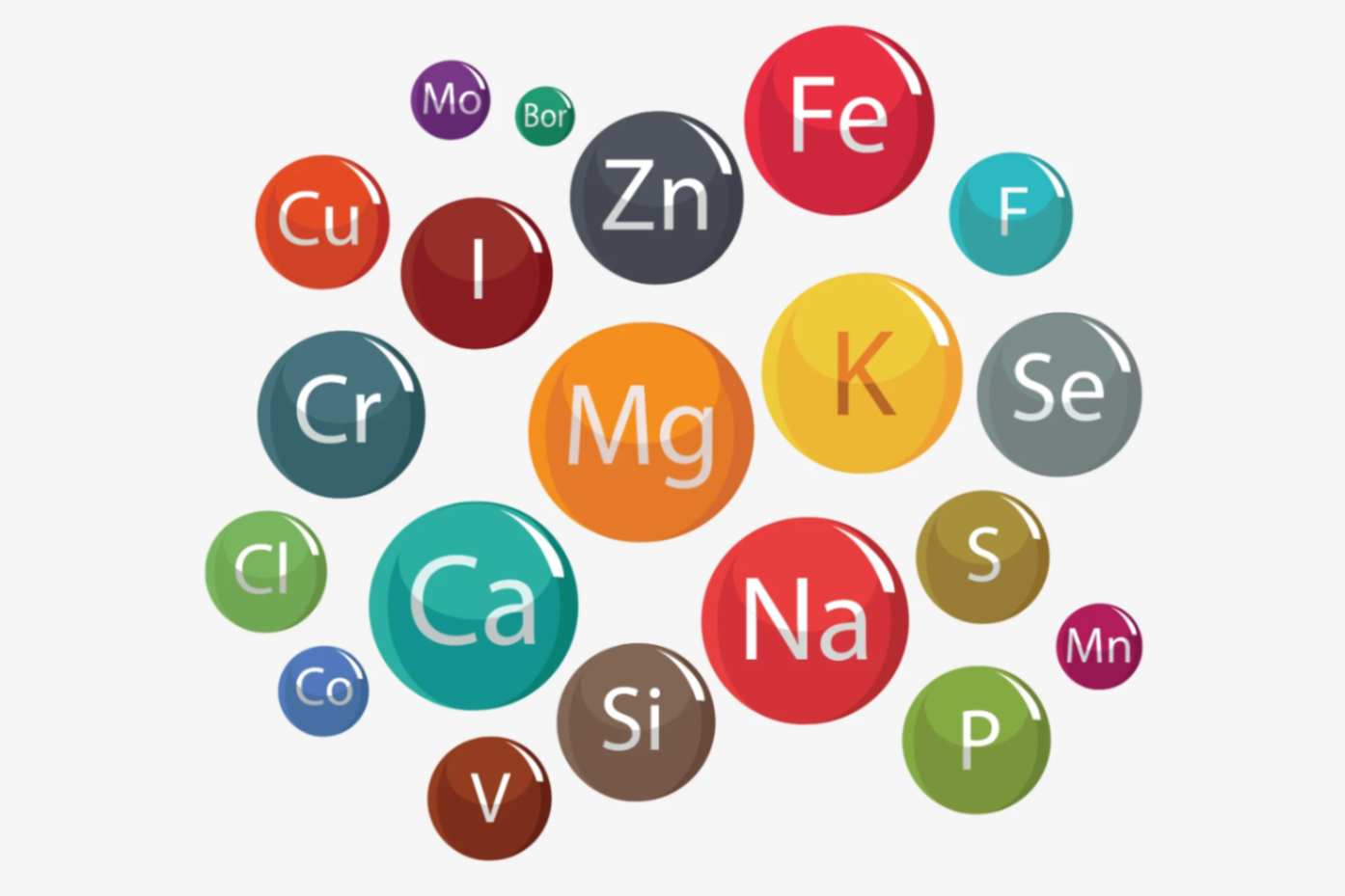At a glance What do minerals do anyway? |
The United States has a mineral problem. No, we are not talking about a lack of rocks. We are talking about the minerals we consume for our health — things like Magnesium, Zinc, Boron, and so on.
Many American adults do not consume enough minerals, which has resulted in noticeable micronutrient inadequacies in the U.S. population. The significance of these nutrients extends beyond basic health requirements; the primary role of minerals is to act as regulators for the many enzymes in our bodies. Enzymes act as a catalyst to create chemical reactions — and those chemical reactions are essential for every system inside our bodies.
Aside from this, minerals also serve as antioxidants that can help defend our cells and tissue from oxidative stress (which causes premature cell aging).
Further, certain minerals play essential roles in the basic metabolic pathways that support cellular function. For example, minerals are involved in energy-yielding metabolism, DNA synthesis, oxygen transport, and neuronal functions vital to brain and muscular function.
And this is just the tip of the iceberg. Read on to discover the truth behind the mineral deficiency in the United States — and learn about the role essential minerals play in our day-to-day and long-term health.
Why Are Americans Mineral Deficient?
We all know that it is important to nourish our bodies with vitamins and minerals. Our bodies need these essential nutrients to work properly – especially when it comes to keeping our muscles and bones strong, hearts healthy, and brain working properly.
However, while vitamins get all of the glory in the news — and some large deficiencies do exist, like Vitamin D deficiency — it’s minerals that all too often get overlooked.
- According to Dr. James DiNicolantonio’s “The Mineral Fix: How To Optimize Your Mineral Intake for Energy, Longevity, Immunity, Sleep and More,” an estimated 1 in 3 Americans is deficient in at least 10 important minerals, including Magnesium, Boron, Zinc, Iron, and Manganese.
- Several studies, including this 2004 evaluation of Department of Agriculture data, have suggested a decline over time in nutritional value in fruits, vegetables, and grains due to mineral depletion in the soil. This particular evaluation examined the changed in USDA food composition data for 43 garden crops from 1950 to 1999.
- Potential causes include problems related to changes in cultivated varieties with some high-yielding plants turning out less nutritious than their predecessors. Other issues such as changes in farming methods, the use of chemical fertilizers, food processing, and preparation all are involved in nutrient value depletion as well.
- The researchers found statistically reliable decline in the following nutrients: Protein, Calcium, Vitamins B2 and C, and Iron.
- Another reason why many Americans are deficient is that they don’t buy the right foods in order to help satisfy the optimal intake of minerals.
The Minerals Behind The Nation-Wide Problem
As stated, approximately one-third of the U.S. population is likely deficient in the following 10 minerals:
- Boron
- Calcium
- Chromium
- Copper
- Iron
- Magnesium
- Manganese
- Molybdenum
- Selenium
- Zinc
All of these minerals — excluding Boron and Copper — are considered “essential.” However, this doesn’t mean that these “non-essential” minerals aren’t important. In fact, Boron has displayed multiple beneficial effects in humans.
With this in mind, let’s dive into what makes Boron special — along with some other minerals that are classified as “essential.”
Boron
Though Boron has yet to be classified as an essential mineral, it is believed to have beneficial effects on biological functions ranging from human development to reproduction.
- Some key areas that Boron supports include calcium metabolism, bone formation, immunity, and joint function. It is even considered a vital brain nutrient!
- According to the US Department of Health & Human Services, Boron is naturally present in food and drink such as prune juice, (1 cup = 1.43 mg per serving), raw avocado (1/2 cup = 1.07 mg), raisins ( 1.5 oz = .85 mg), peaches (1 medium-sized peach = .80 mg), and apples (1 medium-sized apple = .66 mg).
- Aside from food sources, Boron is found in dietary supplements. Boron is present in many different forms such as sodium borate, Boron amino acid chelate, and calcium fructoborate. Most ingested Boron is broken down by our bodies to boric acid in the gastrointestinal tract.
Magnesium
Magnesium is required for more than 300 biochemical reactions in the body. This essential mineral helps maintain normal nerve and muscle function, supports your immune system, regulates your heartbeat, affects your mood, and more. But sadly, a recent review concluded that approximately half of American adults do not consume the Estimated Average Requirement for Magnesium.
- Magnesium intake and absorption has been decreasing in the United States for several decades. One driving force behind this is the change in our daily diets, which increasingly favors fatty and sugar-laden foods to leafy green vegetables, seeds, and raw nuts.
- According to a 2018 review published in Openheart, an open access medical journal dedicated to research in cardiovascular medicine, there has been a substantial decline in the micronutrient density of foods since the 1940s as modern farming techniques began supplanting traditional methods.
- Further, the loss of Magnesium during food refining and processing is significant. For example, Magnesium content in white flour has decreased by 82%, polished rice by 83% and starch by 97%.
- The review also cites the following contributors to the sharp decline in the Magnesium content of food: acidic soil, yield dilution, and unbalanced crop fertilization.
If you’re looking to add more Magnesium to your diet, check out these healthy options on the shelves of your local grocery store: pumpkin seed (1 oz = 168 mg per serving), dry-roasted almonds (1 oz = 80 mg), and spinach (½ cup, boiled = 78 mg).
Additionally, dietary supplements containing Magnesium are available in multiple forms such as Magnesium oxide, citrate, glycinate, and chloride. Keep in mind, however, that our bodies absorb each type of Magnesium differently. For example, Magnesium oxide is not readily absorbed in the bloodstream, whereas Magnesium citrate has shown to be more bioavailable than its mineral counterparts.

Iron
The next essential mineral behind the ongoing mineral deficiency in the United States is Iron. Required by our bodies for growth and development, Iron is needed to make hemoglobin — an important protein in red blood cells that disburses oxygen from our lungs to all parts of our body. Unfortunately, approximately 10 million people are Iron deficient in the United States and, when it comes to the rest of the world, that number balloons to 1.6 billion.
- Adults are not getting enough iron in their diet. There are two types of dietary iron: heme Iron (the kind found in meat, poultry, and fish) and non-heme Iron (found in plant-based foods). Heme Iron is more easily absorbed by our bodies, as compared to non-heme Iron. As a result, those who follow a strict plant-based diet could run into an inadequate dietary intake of Iron.
- The ongoing loss of blood — such as during heavy menstrual periods, regular blood donation, and frequent nose bleeds — are all causes of Iron deficiency in adults as well.
- A blog post by Elissa Rosen, MD, CEDS, states that athletes are at risk for Iron deficiency because they need more than the general population. According to Dr. Rosen, high intensity exercise increases Iron loss by as much as 70%, as compared to adults who lead a lifestyle of minimal physical activity.
There’s no shortage of Iron sources, but our bodies do absorb 2 to 3 times more Iron from animal sources than from plants. With this in mind, let’s check out some food sources that contain the mineral:
- Lean Beef
- Oysters
- Chicken
- Turkey
- Beans and lentils
- Tofu
- Baked potatoes
If you’re looking for other ways to consume Iron, perhaps start with Ferrochel®. According to the official website of the manufacture, Ferrochel® (Ferrous Bisglycinate Chelate) is a unique, fully chelated iron product that is more bioavailable than inorganic iron. The small molecular size allows it to remain intact throughout harsh environment of the G.I. tract for optimal absorption.
Zinc
Zinc is involved in multiple areas of cellular metabolism. Our bodies require Zinc to spearhead the activity of around 100 enzymes, plus it is involved in other roles in immune function, protein synthesis, wound healing, and cell growth and division. Although Zinc is a key mineral for so many critical biological functions, research shows that approximately 1.1 billion people are zinc-deficient due to inadequate dietary intakes. And according to the World Health Organization (WHO) one-third of the world’s population are at risk for zinc deficiency.
- People across the globe are not taking in enough Zinc through their diet.
- Furthermore, people lose excess amounts of Zinc due to poor absorption even when they do eat Zinc-laden foods.
- Additionally, vegetarians typically have lower Zinc levels because the body breaks down Zinc found in meats more efficiently than Zinc from plants.
Similar to Boron, Magnesium, and other minerals, Zinc is naturally present in an abundance of food sources. Meat lovers, poultry afficionados, and seafood supporters, rejoice:
- Meat – Red meat such as beef, lamb, and pork.
- Poultry – Chicken breast, eggs, and turkey.
- Seafood – Shrimp and oysters
Dietary supplements contain Zinc as well. Keep an eye out for Zinc supplements containing 100% TRAACS® Zinc Bisglycinate Chelate — the highly absorbable, patented form of chelated Zinc.
Another patented bioavailable form of Zinc — OptiZinc® — is closely associated with supplements that support fertility and prostate health in men. OptiZinc® is Zinc Monomethionine — a combination of zinc and the essential amino acid methionine. And given its high absorption rate, OptZinc® also makes a great choice for general daily Zinc intake.
Don’t Forget About These Minerals!
Aside from Boron, Magnesium, Iron, and Zinc, other minerals — most of which are classified as essential — are also part of America’s mineral deficiency problem. This is why it is important to understand which nutrients are included in your daily diet, as well as how each mineral works inside your body.
Manganese: A trace mineral, Manganese is only needed in small amounts. However, our bodies require it because it is a cofactor for many enzymes, including manganese superoxide dismutase, arginase, and pyruvate carboxylase. Further, Manganese plays a role in proper immune function, and helps the body metabolize amino acids, carbohydrates, and fat.
- Food sources of Manganese include cooked mussels, dry roasted hazelnuts, brown rice, and spinach.
Chromium: Also a trace mineral, our bodies only need small amounts of Chromium, but it is naturally present in many foods and dietary supplements. Chromium may play a role in carbohydrate, lipid, and protein metabolism, but the exact process behind this activity has yet to be uncovered.
- Chromium content is highest in grape juice, ham, English muffin (whole wheat), Brewer’s yeast, orange juice.
Calcium: We all know that Calcium supports our bones and teeth. However, did you know that it is the most abundant mineral in the body? That’s right — the benefits of Calcium go beyond your bones! This mineral is also required for vascular contraction and vasodilation, muscle function, nerve transmission, and even hormonal secretion.
- Keep in mind, though, that less than 1% of the Calcium in our bodies is needed to support these vital functions; the remaining 99% is stored in your bones and teeth.
- Rich sources of Calcium include milk, yogurt, and cheese. Vegetables such as spinach and kale contain Calcium as well but are not as bioavailable as the Calcium found in dairy products.
Copper: Copper is a cofactor for serval enzymes involved in energy production, iron metabolism, neuropeptide activation, connective tissue synesis, and neurotransmitter synthesis. Plus, it also helps our bodies with other important functions such as brain development and immune system functioning.
- Shellfish, seeds and nuts, and whole-grain products are among the richest food sources of Copper.
Selenium: Another extremely important trace element, Selenium is a component part of multiple selenoproteins that play critical roles in reproduction, thyroid hormone metabolism, DNA synthesis, and even protection from oxidative damage.
- Rich food sources of Selenium include: Brazil nuts, seafood such as cooked yellowfin tuna, canned shrimp, plus meats, namely ham and beef steak.
Molybdenum: The last — but certainly not least — mineral to discuss is Molybdenum. It is an essential trace element that is a cofactor for four enzymes: sulfite oxidase, xanthine oxidase, aldehyde oxidase, and mitochondrial amidoxime reducing component (mARC). And though all four of these enzymes are important, it is sulfite oxidase that is perhaps the most crucial for human health, especially when it comes to kidney function.
- The top food sources of Molybdenum are legumes such as black-eyed peas and lima beans. Other sources include beef, yogurt, and milk.
It’s Time To Fight Back Against A Nationwide Deficiency
Too many Americans are deficient in a wide variety of minerals. Although there isn’t one solution to this ongoing crisis, we can attribute this national deficiency to the following factors:
- Our foods have become more nutrient-depleted than in the past.
- American Adults are not selecting the right foods to hit the optimal intakes of minerals.
- Health problems such as gastrointestinal issues can decrease the amount of minerals our bodies can absorb.
With that in mind, we need to make the conscious effort to fight back against this problem by adding more minerals to our diet — by choosing the right foods, finding foods that have been farmed from mineral-rich soils, and using nutritional supplements when the first two approaches are not a readily-available option.
References
https://www.amazon.com/Mineral-Fix-Optimize-Longevity-Immunity/dp/B08XXZX695
https://balchem.com/human-nutrition-health/products/ferrochel/
https://www.eatright.org/health/wellness/preventing-illness/iron-deficiency
https://medlineplus.gov/ency/article/002423.htm
https://medlineplus.gov/ency/article/007478.htm
https://www.ncbi.nlm.nih.gov/pmc/articles/PMC3685880/
https://www.ncbi.nlm.nih.gov/pmc/articles/PMC5786912/
https://www.ncbi.nlm.nih.gov/pmc/articles/PMC7146416/#B49-nutrients-12-00762
https://ods.od.nih.gov/factsheets/Boron-HealthProfessional/
https://ods.od.nih.gov/factsheets/Calcium-HealthProfessional/
https://ods.od.nih.gov/factsheets/Chromium-HealthProfessional/
https://ods.od.nih.gov/factsheets/Copper-HealthProfessional/
https://ods.od.nih.gov/factsheets/Iron-Consumer/
https://ods.od.nih.gov/factsheets/Magnesium-HealthProfessional/
https://ods.od.nih.gov/factsheets/Manganese-HealthProfessional/
https://ods.od.nih.gov/factsheets/Molybdenum-HealthProfessional/
https://ods.od.nih.gov/factsheets/Selenium-HealthProfessional/
https://ods.od.nih.gov/factsheets/Zinc-HealthProfessional/
https://lpi.oregonstate.edu/mic/micronutrient-inadequacies/overview
https://lpi.oregonstate.edu/mic/minerals/molybdenum#function
https://www.gaudianiclinic.com/gaudiani-clinic-blog/2018/8/29/iron-deficiency-in-athletes









